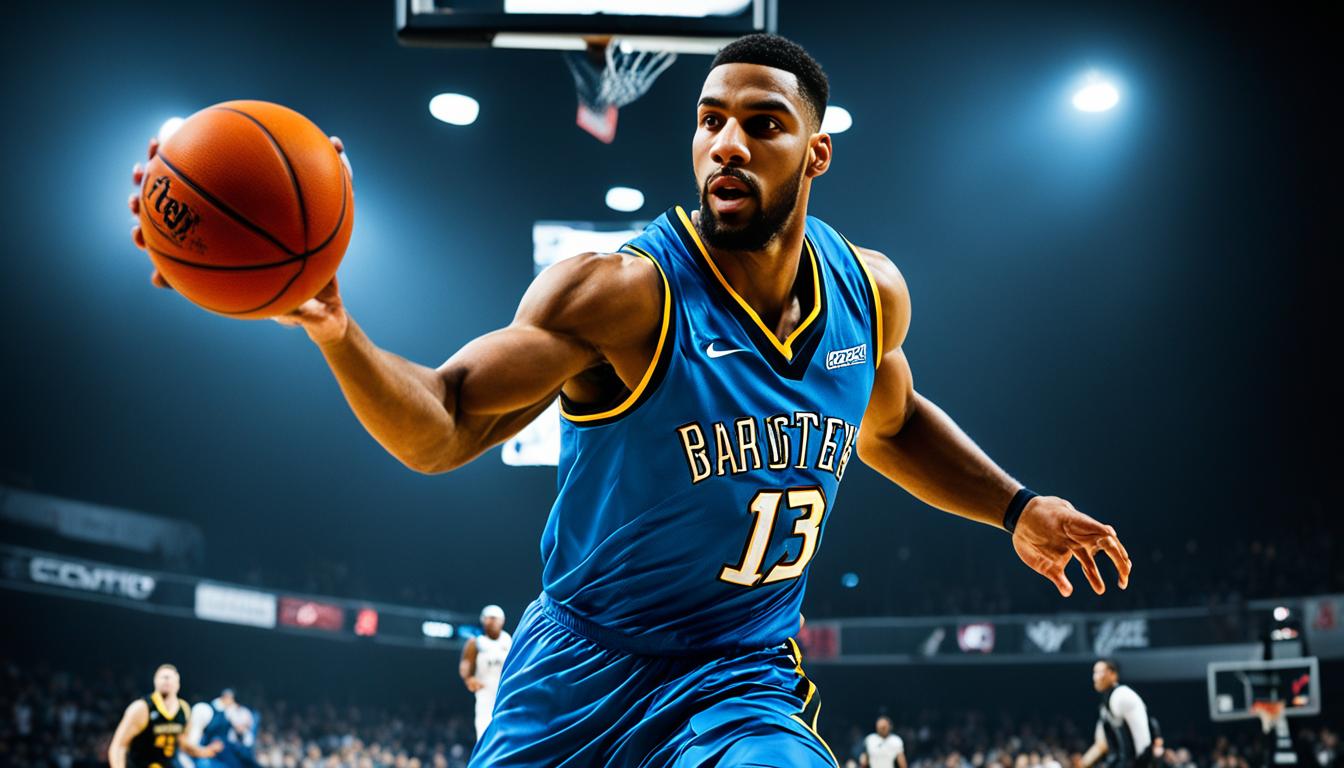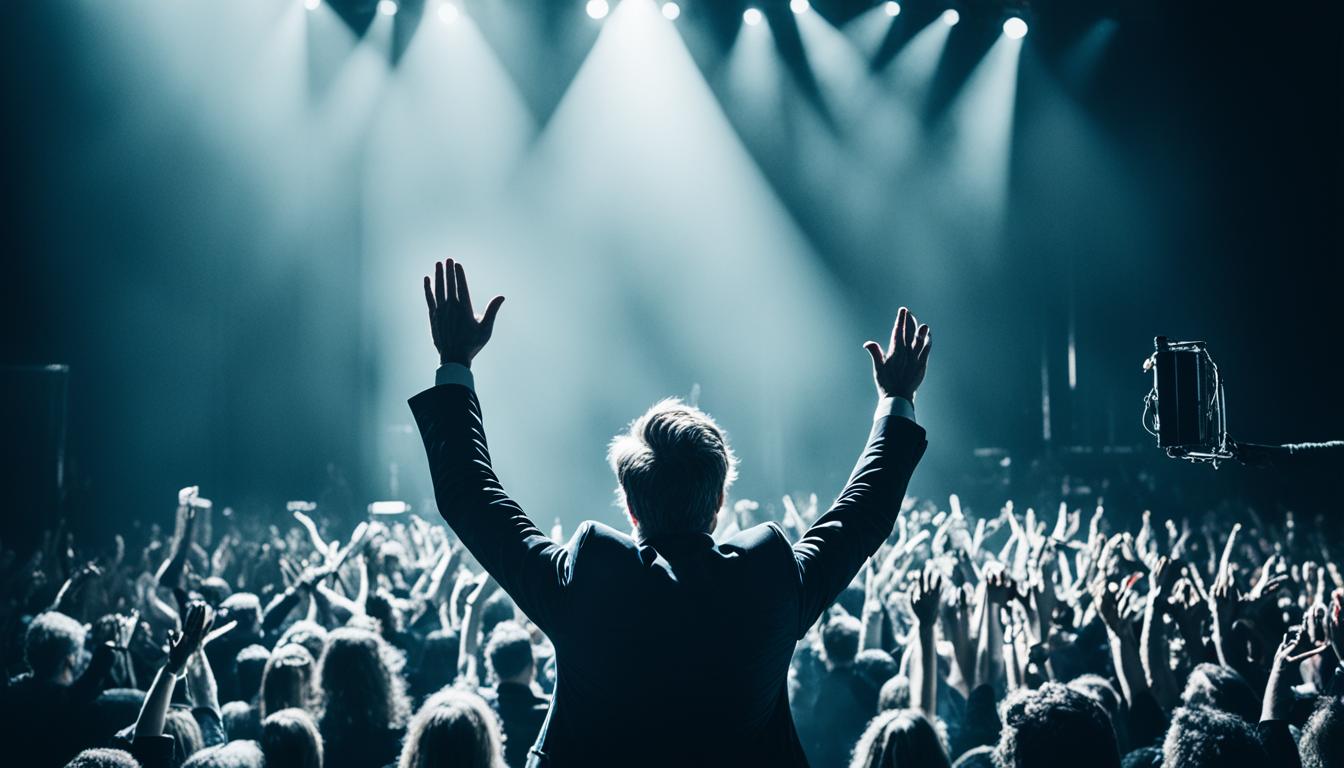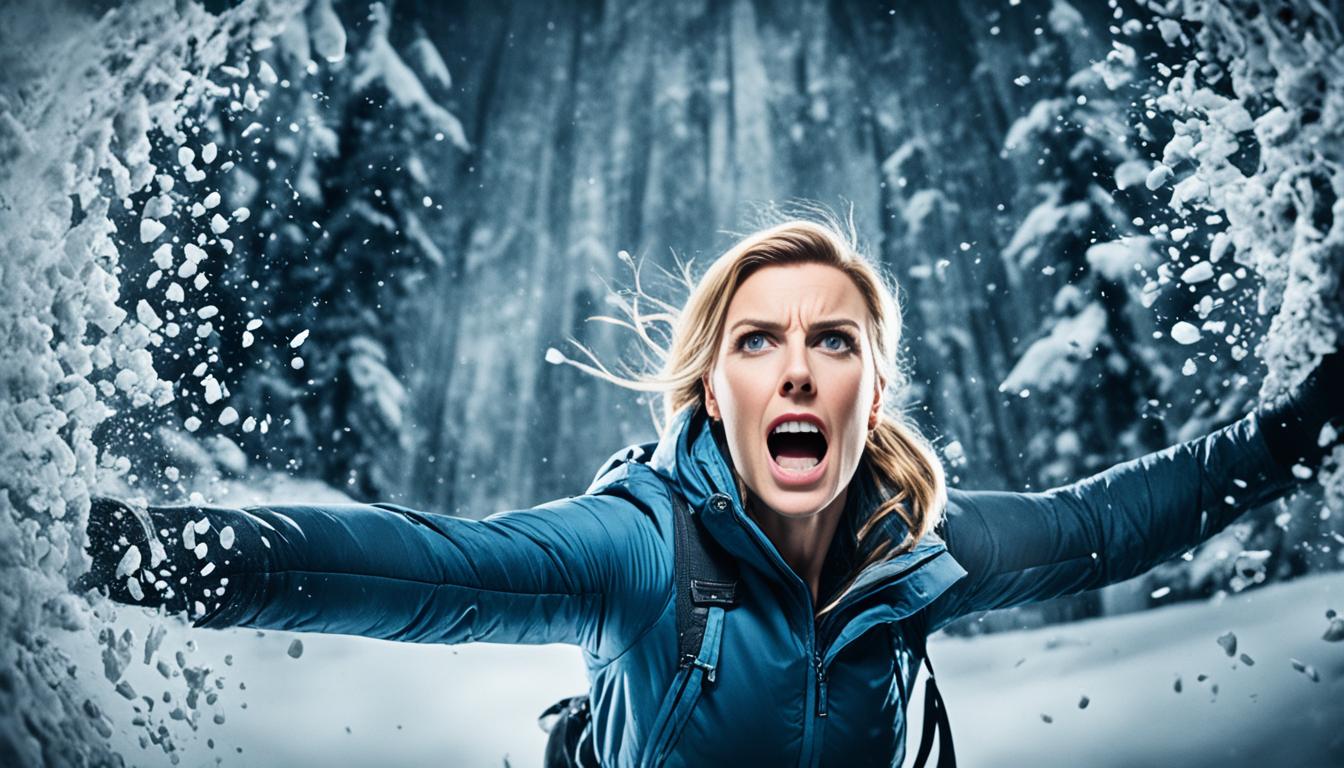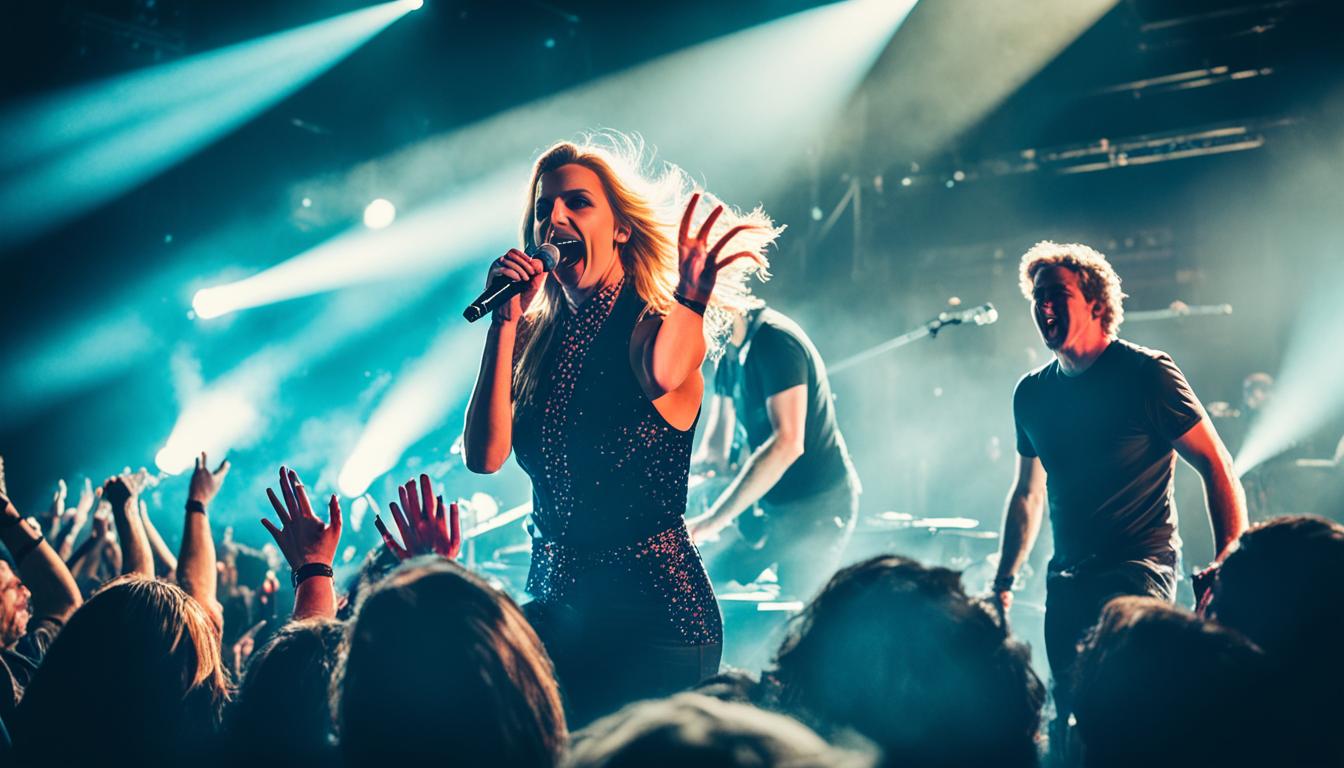As the sun goes down and stadium lights come on, we face a challenge. We must capture fast-moving scenes without losing them to darkness. It’s about mastering Camera Settings for Low Light and Fast Action, learning How to Adjust Camera Settings for Low Light and Fast Movement, and finding the right Low Light Action Photography Settings. We’re excited to take you on this adventure into action photography during the evening or in dimly lit venues.
Key Takeaways
- Get to know the best camera settings for beating low light and stopping fast action.
- Learn how to balance shutter speed, aperture, and ISO for the best picture quality.
- Use fast shutter speeds to get clear shots in low light.
- Adjust your ISO smartly to fit the surrounding light without adding too much noise.
- Focus on aperture settings to let more light hit your camera’s sensor.
- Try different settings to discover the perfect mix for each unique scene and speed of action.
Understanding the Challenges of Low Light Action Photography
Capturing quick moments in dim settings is tough, even for experts. We must look beyond typical camera tricks. It’s key to learn why usual settings don’t work well when the lights are low and action is fast. We aim to grasp the perfect camera settings for dark, quick situations. Let’s explore how to get the right balance of exposure and shutter speed. Understanding ISO adjustments can change our low light photography.
Why Standard Camera Settings Don’t Cut It in Dim Environments
Normal camera presets don’t work well in dark places. These settings can’t keep up with fast movements in low light. Personalized tips for dark photography help replace standard settings. They’re better suited for the challenges we face.
The Trade-off Between Shutter Speed and Exposure in Action Shots
Finding the right mix of shutter speed and exposure is tricky. Too much of one can spoil the picture. A high shutter speed stops fast action but can make photos too dark. On the other hand, a long exposure can make photos brighter but blur moving subjects. We must find a balance to tell the low light story well.
Finding the Balance: Noise, Motion Blur, and ISO
Knowing how noise, motion blur, and ISO interact is key. A high ISO can make photos grainy. But, with careful use, ISO helps reduce blur without losing light. So, our techniques for shooting fast actions often focus on balancing these three. This ensures both our subjects and scenes look their best.
Camera Settings for Low Light and Fast Action
When we dive into the realm of capturing electrifying nighttime action shots, mastering the trinity of aperture, shutter speed, and ISO becomes our mantra. Break it all down, and you have your Low Light Camera Settings Cheat Sheet. This is your secret weapon for dynamic, low-lit moments.
A wide-open aperture allows more light, helping when it’s dim. Think big and wide—forget the narrow views. Shutter speed comes next for crisp imagery without blur, even in fast-paced scenes. Shooting at high speeds like 1/2000 sec is essential to capture motion clearly.
Boosting ISO can risk digital noise, yet it’s a step we take for well-lit, vibrant scenes. A higher ISO helps but needs careful handling. Wondering how to balance it all? Here are our Tips for Shooting Fast Action in Low Light to blend these settings:
- Open the aperture wide – aim for f/2.8 or wider, as your lens allows.
- Start with a baseline shutter speed – 1/500 is good, but go higher for quick action.
- ISO is adaptable – increase it gradually, watching for noise and image clarity.
| Action Scenario | Recommended Aperture | Shutter Speed | ISO Range |
|---|---|---|---|
| Street Performers at Night | f/2.8 | 1/500 | 1600-3200 |
| Evening Sports Event | f/2.8 | 1/2000 | 3200-6400 |
| Cityscape with Moving Vehicles | f/4 | 1/250 | 800-1600 |
Putting these settings into practice can refine your skills. Picture a cityscape at dusk, car lights shining and objects moving. Your settings should smoothly adjust. Check out the image provided for a sneak peek of correctly-set camera capturing moving scenes in shadows.

These tips are just the beginning, a point from where to innovate. Our surroundings challenge us. With practice and this foundation in Camera Settings for Nighttime Action Shots, we can capture the swift, thrilling moments of the night with clarity and brilliance.
Essential Gear for Capturing the Action in Low Light
When tackling the challenges of low light action photography, gear matters just as much as skill. It’s a balancing act. You need fast shutter speeds and must deal with limited light. This is where choosing the right camera settings turns into an art, especially with the perfect equipment.

Choosing the Right Camera Body for High ISO Performance
For low light action shots, a camera that shines at high ISOs is key. Full-frame cameras beat crop sensors in quality and low noise at high ISOs. This quality makes it easier to take great photos in poor light without sacrificing clarity.
The Importance of Fast Lenses in Low Light Action Photography
A fast lens is essential in our low light toolkit. With f/2.8 or wider apertures, these lenses let in lots of light. They also keep shutter speeds quick to capture every action. This way, we don’t miss any detail, even in the dark.
Considering Autofocus Speed for Spontaneous Moments
How fast a lens focuses can make or break capturing action shots. In low light, a fast and precise AF is crucial. Lenses like the Canon 70-200mm series are perfect for this. Their L line autofocus excels in speed and accuracy, capturing every unexpected moment beautifully.
Tips for Shooting Fast Action in Low Light
When tackling low light photography tips and fast action photography techniques, we need to change our methods. Burst mode is key. It lets us take many photos fast, increasing our chance to capture the perfect moment. This mode, paired with continuous focus, sharpens our shots.
It’s vital to check our camera settings before the action starts. This prevents any struggle during the critical moment. It also helps us know how our camera reacts in low light. Techniques like panning or pre-focusing are crucial too. In very low light, using motion blur adds drama and conveys speed using the light we have.
Remember, the key to shooting fast action in low light is being prepared and flexible. We must use our camera’s powers to catch the moment’s spirit, even in poor lighting.
Here’s a quick reference for settings that work well in different scenarios:
| Scenario | Aperture | Shutter Speed | ISO |
|---|---|---|---|
| Indoor Sports | f/2.8 | 1/500 | 3200 |
| Urban Night Scenes | f/4 | 1/250 | 1600 |
| Concerts | f/2.0 | 1/320 | 4000 |
| Wildlife at Dusk | f/2.8 | 1/800 | 3200 |
By using these settings and our knowledge of tips for shooting fast action in low light, we’re set to face the challenges of low light photography.
Best Practices for Aperture, ISO, and Shutter Speed Balance
In the thrilling world of photography, every second is key. Mastering settings for low light and action scenes is crucial. By understanding the balance of aperture, shutter speed, and ISO, perfect shots become second nature.
Starting Points for Aperture Settings in Dim Settings
For low light shots, aperture is key. A wide open aperture, like f/1.8 or f/2.0, brings in more light. But, it’s important to know this can change depth of field and sharpness. Here’s a quick guide for aperture:
- Portraits: f/1.8 to f/2.8 for focused features against a blurred background.
- Landscape: f/2.8 to f/4.0, when the background is just as key.
- Action: f/2.0 to f/2.8 for depth and light balance.
Adjusting Shutter Speed to Capture Motion Precisely
In capturing motion, a quick shutter speed is crucial. For fast subjects, start at 1/500. For very fast action, speeds above 1/2000 freeze the moment. Here’s a quick guide for shutter speed:
| Subject | Recommended Shutter Speed |
|---|---|
| Street Photography | 1/500 to 1/1000 |
| Sports Photography | 1/1000 to 1/2000 |
| Wildlife Photography | 1/500 to 1/2000+, depending on movement |
How to Safely Raise ISO Without Compromising Quality
ISO helps us bring light into dark scenes. But, raising it too much can reduce quality. Thankfully, modern cameras handle high ISO better, so increase it carefully. Below are steps to find the right ISO setting:
- Start with the lowest ISO and increase as needed.
- Use noise reduction to improve image smoothness.
- Experiment with different ISO levels to learn your camera’s limits.
- Use software to reduce noise in high ISO pictures.
Focus and Burst Mode Strategies for Crisp Action Shots
In low light and fast action photography, capturing each moment clearly is key. Using focus and burst mode helps a lot. Burst mode lets us take several pictures in a second. This increases our chances of getting a sharp image during fast movement. It’s crucial for catching all the action without blur.
Adjusting focus settings is important in low light. It helps us keep moving subjects in clear view. This is especially useful for events like nighttime sports. By adjusting quickly, we can capture great photos in different lighting and action. This way, we’re not just taking photos; we’re creating art with light and motion.
Learning to adjust camera settings for low light and action is vital. Practicing these techniques improves our photo quality in dark, moving conditions. It’s more than knowing tips; it’s about active application. This creates a powerful connection between us, the camera, and the changing light and shadows.
FAQ
What are the essential camera settings for low light and fast action photography?
For great shots in low light with fast action, adjust your camera settings. Try a wide aperture like f/1.8 or f/2.0. Use a high shutter speed, maybe 1/500 or higher for super fast action. Set your ISO high enough to keep your image bright but not too noisy.
How do you adjust camera settings for low light and fast movement?
To capture sharp images of fast action in dim light, begin with a wide-open aperture. This lets in more light. Then, speed up your shutter to freeze the action. Adjust your ISO higher until the picture looks just right. The right mix depends on the speed of movement and dimness.
What are the best camera settings for low light?
For scenes with low light, start with a big aperture to bring in light. Use the slowest shutter speed that still keeps images clear (a tripod helps). Increase your ISO for a well-exposed photo. If action is happening, you’ll need a quicker shutter speed and maybe a higher ISO.
Why don’t standard camera settings work well in dim environments?
Regular camera settings usually aim for well-lit, still scenes. In darker places with action, these won’t work well. You’ll need to tweak your aperture, shutter speed, and ISO to different levels than usual.
What is the trade-off between shutter speed and exposure in action shots?
It’s a balance. High shutter speeds capture clear, fast-moving subjects. But, you need slower speeds to let in enough light for a good exposure. Finding the middle ground is crucial for low light action photos.
How do I find the balance between noise, motion blur, and ISO in low light action photography?
To get the balance right, start with the widest aperture your lens supports. Pick a shutter speed that stops the action. Then, up your ISO just enough to light up your photo without too much noise. Noise reduction software helps afterwards.
What camera body and lenses are best for capturing action in low light?
Choose a camera that keeps noise low at high ISOs. Full-frame bodies are usually better for this. Get fast lenses with wide apertures (like f/2.8 or wider) for more light. Fast, accurate autofocus lenses are also key in low light.
Why is autofocus speed crucial in low light action photography?
In dim scenes with moving subjects, fast and dependable autofocus is key. It lets you capture sharp pictures in fleeting moments. Quick autofocus tackles the challenge of getting clear shots in tough conditions.
What are some tips for adjusting aperture settings in dim scenarios?
Start with your lens’s widest aperture, maybe f/1.8 or f/2.0, for maximum light. If you’re worried about depth or sharpness, try stopping down to f/2.8 or f/4.0. This can enhance detail in your shots.
How should I adjust shutter speed to capture motion precisely?
Start with a shutter speed of 1/500 for most moving subjects. For faster action, bump it up to 1/1000 or even 1/2000. Adjust through test shots to perfectly freeze the action in your scene.
What strategies can I use to raise ISO without compromising image quality?
To keep noise low at high ISOs, start with the lowest ISO that still gives you a good exposure. Increase it step by step from your camera’s native ISO. Modern cameras handle high ISOs better. Shooting in RAW also helps with noise reduction later.
How do focus and burst modes help with crisp action shots in low light?
Use continuous focus (servo AF) to keep moving subjects in focus. With burst mode, you take many shots per second, improving your odds of a sharp photo. These tools help capture the best action shots in a sequence.




